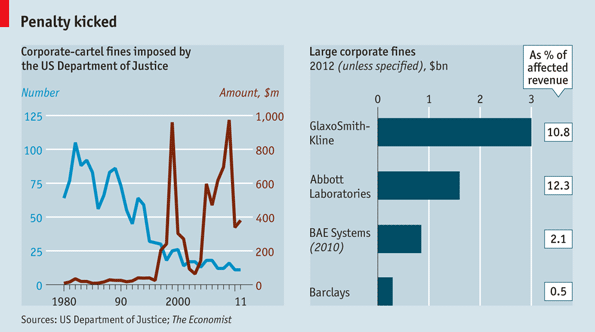Why We Need To Punish Financial Crime More
The Article: Fine and punishment in the Economist.
The Text: IT HAS been a bumper summer for corporate fines and settlements. In the past three months alone firms in Britain and America have agreed to pay out over $10 billion because of wrongdoing. But the economics of crime suggests that fines imposed by regulators may need to rise still further if they are to offset the rewards from lawbreaking.
The latest allegations of bad behaviour are a familiar brew of overcharging, mis-selling and price-fixing. Banks have been the worst offenders. Barclays was fined $450m for its part in a price-fixing scandal; others will follow. HSBC is expected to receive a hefty fine for allegedly flouting money-laundering regulations. Two pharmaceuticals firms, GlaxoSmithKline and Abbott Laboratories, have been stung for illegal marketing.
That some firms behave badly is nothing new, but the response of the authorities has changed recently. Take cartels. Internationally, fines rose by a factor of one thousand between the 1990s and 2000s. Data from America suggest this is not because there are more cartel cases, which have shown no upward trend since the late 1980s. Rather, the average level of fines has risen (see left-hand chart). Recent penalties have smashed records. The Barclays fine includes the largest ever levied by Britain’s financial regulator and America’s Commodity Futures Trading Commission, for instance. Even so, are fines high enough to work?
The economics of crime prevention starts with a depressing assumption: executives simply weigh up all their options, including the illegal ones. Given a risk-free opportunity to mis-sell a product, or form a cartel, they will grab it. Most businesspeople are not this calculating, of course, but the assumption of harsh rationality is a useful way to work out how to deter rule-breakers.
In an influential 1968 paper on the economics of crime, Gary Becker of the University of Chicago set out a framework in which criminals weigh up the expected costs and benefits of breaking the law. The expected cost of lawless behaviour is the product of two things: the chance of being caught and the severity of the punishment if caught. This framework can be used to examine the appropriate level of fines, and to see if there are ever reasons to exempt companies from fines.

In thinking about how to set fines, it helps to start from the extremes. One option is to have no fines at all for corporate wrongdoing, and to rely instead on market forces to impose the costs that keep firms in line. The market-based approach to antitrust regulation, popularised by Aaron Director of the University of Chicago, holds that antitrust violations must be ripping someone off, whether a customer or a supplier. The same is true of mis-selling cases. In time a firm acting in this way will lose business, meaning that crime will not pay.
The problem with this view is that frictions—the costs to customers of switching, say, or the barriers to entry for competitors—can allow exploitative firms to escape punishment. Market constraints alone are not always enough to ensure good behaviour. In a 2007 paper, John Connor and Gustav Helmers of Purdue University examined 283 international cartels that operated between 1990 and 2005. The aggregate revenue increase these cartels achieved by acting as they did was over $300 billion.
At the other extreme is a system of very high fines. Indeed, Mr Becker’s crime calculus might lead to the conclusion that fines should be as draconian as possible—seizing all a wrongdoer’s assets, for example. Anything lower reduces the expected cost of criminality, without doing anything to improve the probability of detection. (Treating whistleblowers leniently is consistent with this logic: letting them off punishment raises the odds of truth-telling, and therefore of detection.) There are plenty of arguments against ultra-high fines, however. One is that false convictions carry too high a cost. Another is that fines of this sort could cripple firms, reducing competition.
A middle way might be for regulators to levy penalties that offset the benefits of crime. Data on cartels supply useful guidance on how to go about calculating these fines. The first step is to measure the expected gain from crime which fines need to offset. In the study by Messrs Connor and Helmers, the median amount that cartel members overcharged was just over 20% of revenue in affected markets. Next, you need an assumption about the chances of being found out: a detection rate of one cartel in three would mean trustbusters were doing well. In this example, that would mean a fine of 60% of revenue is needed to offset an expected benefit of 20% of revenue—far higher than the fines in the study, which were between 1.4% and 4.9%.
The calculus of crime
Assessed against this methodology, even apparently hefty fines look pretty weak. Recent big penalties (see right-hand chart) have been far lower than a crime calculus of this sort would suggest is needed, even allowing for the fact that some firms, like Barclays, get discounts for co-operating with the authorities. Britain looks particularly lenient. Its antitrust laws impose fines of up to 10% of revenues; American regulators levy penalties of up to 40%, and the European Commission goes up to 30%.
Disgruntled customers may later bring private lawsuits, which can further raise the cost of crime. Here crime economics would suggest the American “class action” system, bunching many customers’ complaints into a single lawsuit, is an asset Europe lacks. MasterCard and Visa this month agreed to a $7.3 billion settlement to resolve retailers’ lawsuits alleging collusion (which the two firms deny) over credit-card fees. Criminal charges against individuals can also focus minds. Yet litigation and criminal charges tend to take years to emerge; many wrongdoers are able to avoid court. To deter bad behaviour fines need to rise. The watchdogs are biting, but some need sharper teeth.









